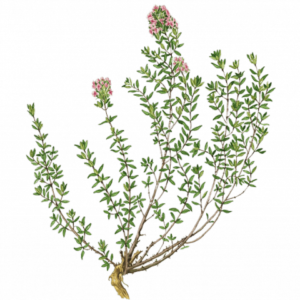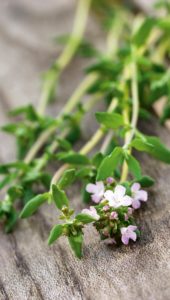

COMMON THYME THYMOL
Thymus vulgaris
Thymoliferum
DESCRIPTIONS

Common thyme (Thymus vulgaris) is a perennial subshrub of the Lamiaceae family that prefers stony ground and sun-drenched garrigues.
ADVICE
Essential oil of thyme is an stimulant: it should not be used after 5pm. It is aggressive to skin when used pure; consequently, it should not be used on large areas of skin and should be diluted to no more than 5% in a carrier oil. Specialist advice is required for oral use as it is hepatotoxic at high doses over extended periods. For cooking, one drop of essential oil is enough to perfume a dish for five to six persons.
DO NOT USE IN
– pregnant or breast-feeding women,
– children under the age of twelve years,
– persons allergic to one of the components (geraniol, linalool, limonene),
– subjects with asthma without the advice of an allergologist before the first use,
– subjects with epilepsy,
– pure taken orally, in persons with a history of gastritis, peptic ulcer, viral hepatitis B, C or D.
RECIPES
Mouth ulcers
Using a cotton bud, apply 1 to 2 drops of essential oil of thyme thymol to the mouth ulcer, taking care not to overlap onto the gums. Repeat five times daily.
Bronchitis
20 drops of EO of thyme thymol, 10 ml of neutral CO.
Mix the oils and massage the soles of your feet two to three times per day, for four to five days.
General fatigue
Mix 5 drops of essential oil of thyme thymol with 5 drops of essential oil of clove in 10 ml of neutral carrier oil; massage the soles of your feet in the morning before showering.
Chill
Sweeten a lemon juice drink with 1 drop of essential oil of thyme thymol diluted in a spoonful of honey.

Growing to a height of seven to twenty centimetres, it has woody cylindrical stems arranged in clumps or dense bushes. Its small greyish leaves are oval and lanceolate; its highly melliferous flowers blossom in spikes at the leaf axils. Wild thyme, or shepherd’s thyme, possesses similar properties.
For thousands of years, humans have used thyme, that grows wild around the whole Mediterranean basin, to cure themselves and to enhance the flavour of their food. The Egyptians used it for embalming and Crete and Cyprus, laboratory islands for aromatic plants, ascribed great importance to this plant beloved by Aphrodite. The Romans used it in their toilet waters and beauty creams. A legend arose from the bitterness of thyme: it arose from the tears of the beautiful Helen, tormented by remorse for having caused the Trojan war. The fact that bees should make such a sweet honey from this bitterness impelled Plutarch to claim that, in this, they resembled “brave men able to derive benefit from their austere way of life”. Taken as an infusion, thyme is one of the favourite “grandmother’s medicine” remedies, used against considerable number of ailments, from indigestion to whooping cough.
CULTIVATION AND PRODUCTION
Worldwide thyme exchanges are estimated at two thousand tonnes per year. It is cultivated in France over nearly three hundred hectares, though it is faced with increasing competition from Turkey, Poland, Morocco and Spain.
FRAGRANCE
The odour of thyme, whose strength varies with variety, is both grassy and spicy. It is so pleasant that the plant derives its name from the Greek thyo, “to smell good, embalm”.
EXTRACTION AND YIELD
The steam distillation of the flowering tops of thyme gives a yield of 1.7 to 2.5%, i.e. seventeen hundred grams to two kilograms of essential oil from one hundred kilograms of plant.
CHEMICAL FORMULA
A distinguishing feature of thyme is that it possesses seven main chemotypes, each of which has a strong dominant (alpha-terpineol, thymol, geraniol, linalool, paracymene and thujanol). The main active constituent of essential oil of Thymus vulgaris thymoliferum is a phenol (thymol).
MAIN INDICATIONS
Thyme is a potent antiseptic, antibacterial, antiviral, antifungal and anti-parasite agent. As such, it is used to treat “difficult” infections, both ENT, genito-urinary, respiratory and digestive. It is also an immune stimulant and general tonic; as such, it is recommended in cases of flu and fatigue.


Leave a Comment